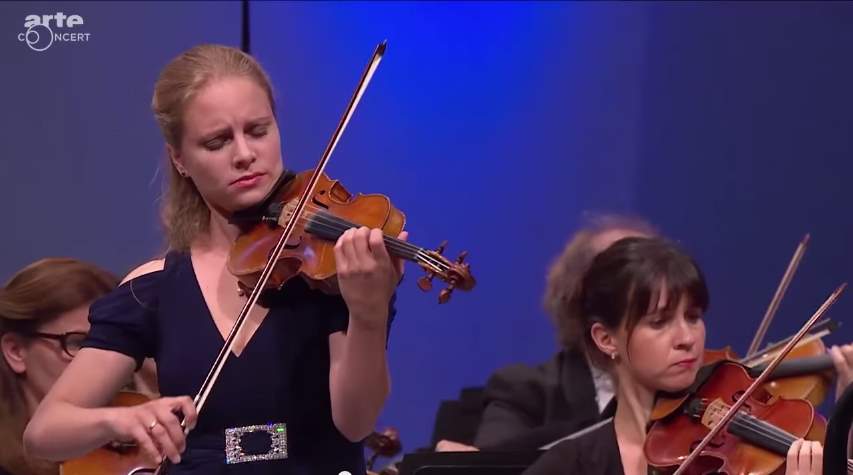Accompanied by the London Philharmonic Orchestra, the German classical violinist and pianist Julia Fischer performs Felix Mendelssohn’s Violin Concerto in E minor, Op. 64. Conductor: Vladimir Jurowski.
1. Allegro molto appassionato (00:25) 2. Andante (13:09) 3. Allegretto non troppo — Allegro molto vivace (20:15)
Mendelssohn’s Violin Concerto
Mendelssohn’s Violin Concerto in E minor, Op. 64, is one of the most popular and frequently performed violin concertos in the classical repertoire. It was composed by Felix Mendelssohn in 1844 and premiered in 1845 and is known for its lyrical melodies, virtuosic violin solos, and brilliant orchestration. It’s the last concerto that Felix Mendelssohn (3 February 1809 – 4 November 1847) wrote.
Movements
The concerto consists of three movements with the following tempo markings (with start times in the video):
- [00:25] Allegro molto appassionato (E minor).
- [13:09] Andante (C major).
- [20:14] Allegretto non troppo – Allegro molto vivace (E major).
1. Allegro molto appassionato
Instead of an orchestral tutti, Mendelssohn’s violin concerto opens with the almost immediate entry of the solo violin. Marked Allegro molto appassionato, which means “very fast and passionately,” it is a tour-de-force for the soloist, featuring virtuosic violin passages and soaring melodies.
The soloist plays a rapid and virtuosic passage, followed by a beautiful and lyrical melody. This melody is developed and elaborated upon throughout the movement, showcasing Mendelssohn’s gift for melody and harmonic structure.
The development section of the movement features a series of fast and complex violin passages, as well as a beautiful and delicate theme played by the woodwinds. The soloist’s technical virtuosity is fully displayed in this section, as they navigate the fast and intricate runs and arpeggios.
The movement concludes with a brilliant and triumphant coda, which restates the main theme in a series of thrilling and virtuosic violin passages. The concerto’s first movement is a beautiful and emotionally powerful piece of music that has remained a beloved favorite of violinists and music lovers alike.
2. Andante
The second movement of the Mendelssohn Violin Concerto is marked Andante, which means “at a walking pace.” It is a beautiful and tender movement that contrasts with the fast and passionate first movement.
The bassoon sustains its B from the final chord of the first movement before moving up a semitone to middle C. Then the solo violin takes it over and plays a delicate and introspective melody. This melody is one of the most beautiful and memorable in the entire concerto, and it showcases Mendelssohn’s gift for lyricism and emotional depth.
The solo violin then introduces a second theme, which is more expressive and passionate than the first. The orchestra picks up this theme and develops it further.
The movement concludes with a reprise of the opening melody, played by the solo violin over a lush orchestral accompaniment. The melody gradually fades away, leading directly into the third and final movement of the concerto.
3. Allegretto non troppo
The finale of Mendelssohn’s Violin Concerto is marked Allegretto non troppo – Allegro molto vivace, which means “moderately fast – very lively.” It is a brilliant and energetic movement that brings the concerto to an exciting and satisfying conclusion.
The movement begins with a lively and syncopated orchestral introduction, which leads into the soloist’s first statement of the main theme. This theme is marked by fast and virtuosic violin passages, as well as syncopated rhythms that give the movement its lively and energetic character.
The opening exposition leads into a brief second B major theme which is played by the soloist and builds to a series of rapidly ascending and descending arpeggios, reminiscent of the cadenza from the first movement. The orchestra then plays a variation of the opening melody, after which the music moves into a short development section in G major.
The recapitulation is essentially similar to the exposition, apart from the addition of a counter-melody in the strings. The second theme is repeated, this time in the home key of E Major. There is almost a small cadenza near the end of the movement when the woodwinds play the main tune against prolonged trills from the solo violin. The concerto then concludes with a frenetic coda.
Sources
- Violin Concerto (Mendelssohn) on Wikipedia
- Julia Fischer on Wikipedia
- Julia Fischer’s official website

![Mendelssohn: Violin Concerto [Julia Fischer]](https://cdn-0.andantemoderato.com/wp-content/uploads/2023/04/Julia-Fischer-Mendelssohn-Violin-Concerto-1024x572.jpg)

